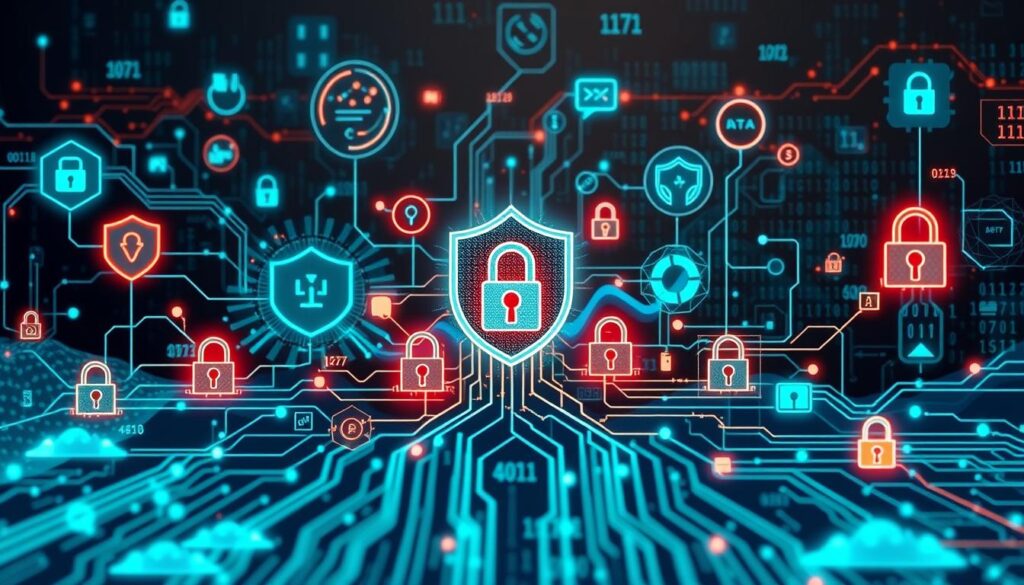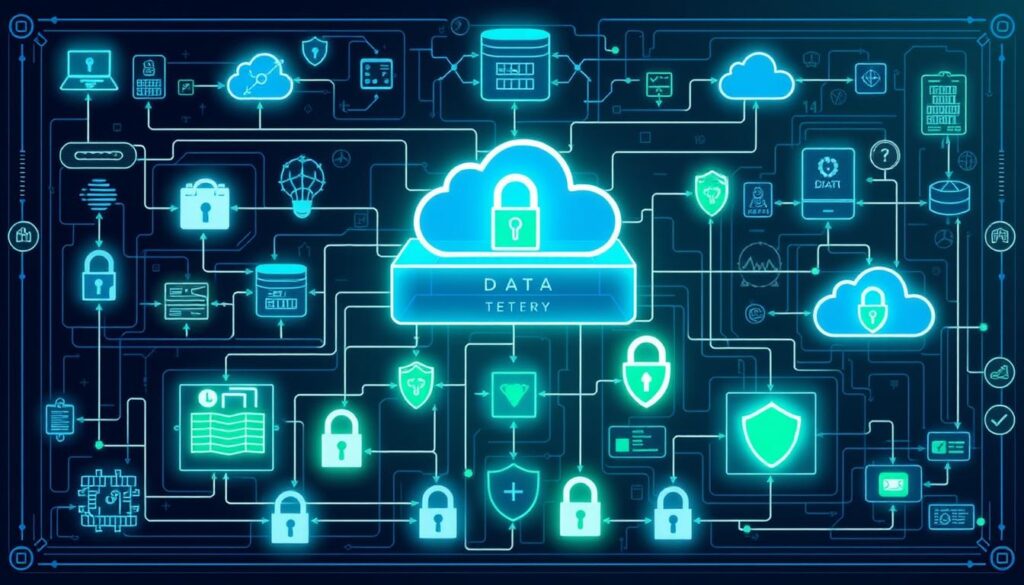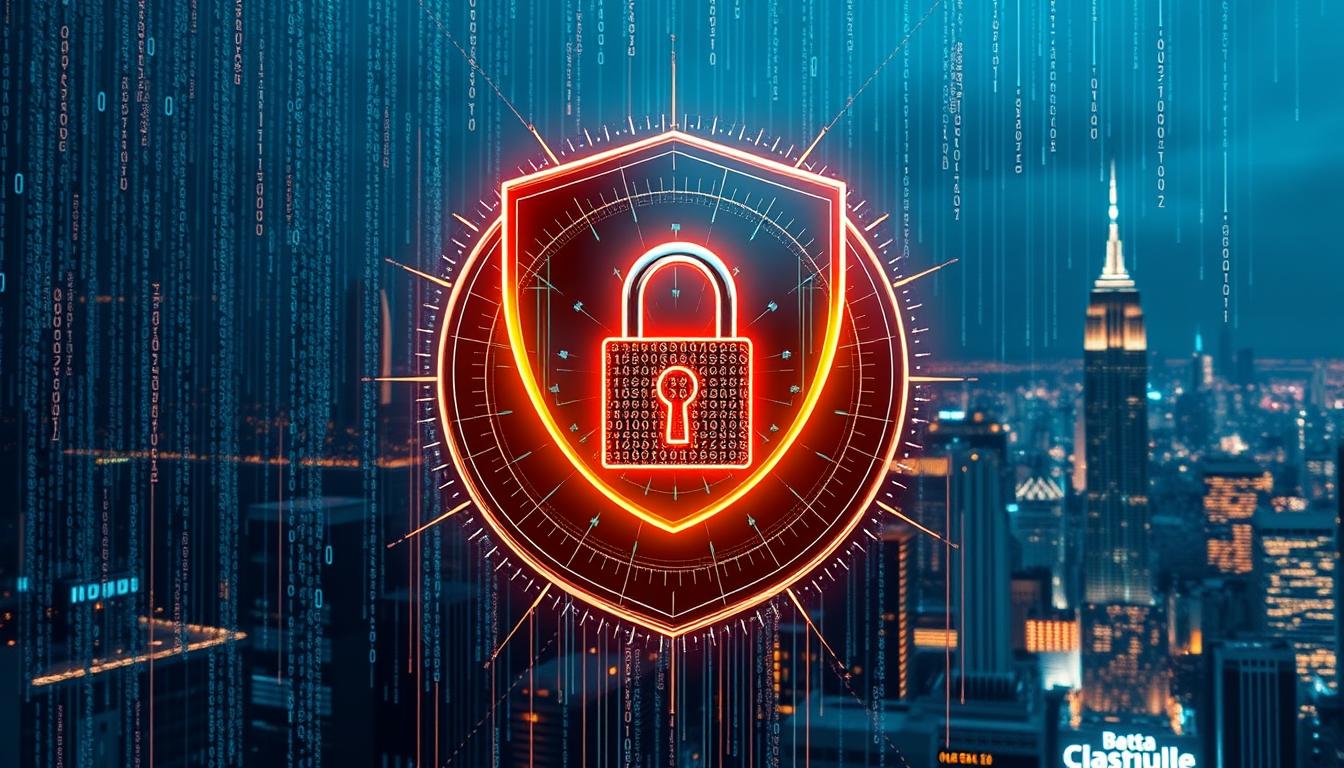Cybersecurity Best Practices to Protect Your Data
In today’s digital world, keeping your organization’s data safe is more important than ever. Cybersecurity best practices are now a must, not just a choice. With 43% of cyberattacks hitting small businesses and 89% of breaches aimed at making money, it’s key to know how to protect your network and manage risks.
The digital world is full of challenges. Cybercriminals keep finding new ways to attack, making it hard to keep data safe. Your company must be ready to face these threats and protect your sensitive information, money, and reputation.
To build strong cybersecurity, you need a complete plan. This includes managing passwords and watching your network closely. The aim is to set up strong defenses that keep attackers away and reduce risks.
Table of Contents
Understanding the Importance of Data Protection
In today’s digital world, keeping your organization’s data safe is more important than ever. Cyber threats are changing fast, making it hard for businesses in all fields. With 77% of companies not ready for cyberattacks, knowing how to protect data is crucial.

The digital world brings big challenges for keeping data safe. Cybercriminals are getting smarter, using many ways to attack companies.
The Growing Threat Landscape
Modern cyber threats have changed a lot. Key challenges include:
- Sophisticated ransomware attacks
- Advanced phishing techniques
- Cloud security vulnerabilities
- Endpoint device risks
Cost Impact of Cybersecurity Breaches
Data breaches can hurt businesses a lot. The global average cost of a data breach in 2023 was $4.45 million. These incidents can lead to:
- Big financial losses
- Loss of customer trust
- Potential legal problems
- Disruptions to operations
Modern Security Challenges
“Cybersecurity is no longer about building walls, but about managing risk in an interconnected world.”
Companies need strong data protection plans to face new tech challenges. This means always learning, using flexible security, and being proactive about finding and fixing vulnerabilities.
Fundamentals of Data Security Systems

Learning about data security systems is key to keeping your digital assets safe. These systems are the core of today’s cybersecurity. They help protect against new digital dangers.
Data security has many layers of protection. It covers different database types. Companies need to choose the right defense for their data:
- One-tier database models for small-scale operations
- Two-tier systems for intermediate complexity
- Three-tier architectures for enterprise-level security
Encryption is vital in data security. Each database type, like SQL and NoSQL, needs its own security plan. This keeps data safe and follows rules about protecting it.
“In the digital age, data security is not an option—it’s a necessity.” – Cybersecurity Expert
Keeping data safe also means using the right storage. Today’s companies use advanced tools like Storage Area Networks (SANs). These tools help with:
- Redundant server setups
- Fast data connections
- Easy data access
Following rules like GDPR and CCPA is crucial. Good security plans help companies avoid risks. They keep important data safe.
| Database Model | Security Complexity | Recommended Use |
|---|---|---|
| One-Tier | Low | Small businesses |
| Two-Tier | Medium | Mid-size enterprises |
| Three-Tier | High | Large corporations |
Knowing about these data security basics helps you stay ahead of cyber threats. It’s a step towards keeping your digital world safe.
Essential Cybersecurity Best Practices for Organizations
Keeping your organization’s digital assets safe is key. Cybersecurity is now a must for every team, not just IT. It’s a business priority.
Today, organizations face big challenges in keeping data safe. Cyber threats are getting smarter. Here are some ways to strengthen your digital security:
Implementation of Robust Security Strategies
Creating strong security plans means using many layers:
- Implement multi-factor authentication across all systems
- Utilize password management solutions
- Enforce the principle of least privilege
- Deploy endpoint detection and response (EDR) technologies
Regular Security Audits
Regular checks are key to spotting weak spots:
| Audit Focus Area | Recommended Frequency |
|---|---|
| Network Infrastructure | Quarterly |
| Access Control Systems | Bi-Annually |
| Compliance Verification | Annually |
Employee Training Programs
Your team is your first defense against cyber threats. Good training should:
- Educate staff on recognizing phishing attempts
- Provide practical cybersecurity awareness training
- Simulate real-world cyber attack scenarios
- Establish clear reporting procedures for suspicious activities
“Cybersecurity is a shared responsibility. Every employee plays a critical role in protecting organizational data.” – Cybersecurity Expert
By using strong security plans, doing regular checks, and training your team, you can lower cyber risks. This helps protect your most important digital assets.
Data Encryption and Protection Methods
Keeping your digital info safe needs strong encryption plans. These plans protect your data from cyber threats. In today’s world, where hackers are always looking for weak spots, keeping your data safe is key.
There are many encryption methods, each with its own benefits. Knowing about these can help you protect your digital stuff well.
Key Encryption Technologies
- Advanced Encryption Standard (AES): Supports key sizes of 128, 192, and 256 bits
- RSA Encryption: Uses public and private key mechanisms
- Elliptic Curve Cryptography (ECC): Provides high security with shorter key lengths
Companies can use different encryption methods to protect their data in layers. Full-disk encryption secures entire systems, while file-level encryption keeps individual files safe.
“Encryption is the foundation of digital security in the modern era.” – Cybersecurity Expert
Encryption Performance Metrics
| Encryption Method | Key Size | Block Size | Primary Use |
|---|---|---|---|
| AES | 128-256 bits | 128 bits | Global Standard Encryption |
| Twofish | 128-256 bits | 128 bits | File/Folder Encryption |
| RSA | Variable | Internet Communications | Asymmetric Encryption |
Choosing the right encryption method depends on your security needs. Think about how sensitive your data is, how fast it needs to be, and if it meets legal rules.
Also, make sure to handle your encryption keys safely and update your security often. This keeps your data safe from new cyber threats.
Access Control and Authentication Measures
Keeping your digital assets safe needs a strong plan for access control and authentication. Cybersecurity experts say that good access management is key to stopping security breaches.
Today’s companies face big challenges in keeping their digital spaces safe. Access control is a key security tool. It decides who can see, use, and interact with certain resources in your system.
Multi-Factor Authentication
Multi-factor authentication (MFA) adds a vital layer of security beyond just passwords. It asks for more than one way to prove who you are. This makes it much harder for hackers to get in.
- Combines two or more independent credentials
- Typically includes something you know, have, or are
- Reduces potential security vulnerabilities by 99.9%
Password Management Best Practices
Good password management is key for strong security. Having solid password strategies helps keep your sensitive info safe from cyber threats.
| Password Strategy | Recommendation |
|---|---|
| Password Complexity | Minimum 12 characters, mix of uppercase, lowercase, numbers, symbols |
| Password Rotation | Change passwords every 60-90 days |
| Password Storage | Use encrypted password management tools |
User Permission Protocols
Following the principle of least privilege means users only get to what they need. This reduces risks and stops unauthorized data leaks.
“Security is not about perfect protection, but about managing risks effectively.” – Cybersecurity Expert
By using strong access control and authentication, your company can boost its cybersecurity. This helps protect your digital assets from threats.
Backup Strategies and Data Recovery
Keeping your digital assets safe is key. Sadly, three out of four companies face sudden data loss. Almost half of them lose their data forever. This shows how vital good disaster recovery and business plans are.
“Your data is your most valuable digital asset. Protect it with a strategic backup approach.”
The best way to back up data is the 3-2-1 strategy. It offers strong protection:
- Maintain 3 copies of your data
- Store 2 copies on different local media
- Keep 1 copy offsite or in the cloud
Good backup plans do more than just copy files. They use advanced methods for better security and recovery:
| Backup Technique | Protection Level |
|---|---|
| Encryption | Prevents unauthorized access |
| Immutable Storage | Blocks data alteration |
| Air-gapping | Disconnects backups from network |
Continuous Data Protection (CDP) is a top-notch backup method. It tracks changes to ensure quick recovery. It’s also important to test your backups regularly. This way, you can be sure your system will recover fast when needed.
Your backup plan is more than just a technical need. It’s essential for keeping your business running smoothly. Spend time and resources on a solid plan to safeguard your digital assets.
Network Security and Infrastructure Protection
Keeping your digital infrastructure safe is key. Cyber threats keep getting smarter. It’s vital for businesses of all sizes to protect their networks well. Knowing the basics of network security helps keep your important data safe from big breaches.
Good network security is more than just a few tools. It’s about building strong defenses. These defenses work together to spot, stop, and handle threats.
Firewall Configuration
Your network’s first defense is a good firewall. Experts say to set up firewalls in a way that:
- Divides network traffic into clear zones
- Creates safe areas (DMZ) for outside services
- Uses NAT for better privacy
- Has personal firewalls on each device
Network Monitoring Tools
Keeping an eye on your network is crucial. Top-notch monitoring tools help you:
- Watch for odd network actions
- Spot security breaches as they happen
- Control who can access the internet
- Make sure users only have the access they need
Threat Detection Systems
Today’s threat detection uses the latest tech to find and stop risks. Important steps include:
- Systems that find and block intrusions
- Whitelisting apps
- Using honeypots to learn about attacks
- Watching network protocols in real-time
“Network security is not a product, but a process of continuous improvement and adaptation.” – Security Expert
Cyber attacks hit 86% of organizations. Small to medium businesses are especially at risk. So, strong network security is not just a good idea—it’s a must.
Mobile Device and Remote Access Security
In today’s world, keeping mobile devices and remote access safe is key for companies everywhere. With 85% of businesses facing mobile security breaches in the last year, protecting these areas is crucial.
To tackle mobile security, a detailed plan is needed. Your company should concentrate on several main points:
- Device encryption
- Mobile device management (MDM) solutions
- Strict BYOD policies
- Secure remote access protocols
Remote access brings its own set of challenges. 70% of organizations now use multifactor authentication for VPN connections, showing the need for better security. When making your mobile security plan, remember these important parts:
- Operating system security features
- Application security protocols
- Network security mechanisms
- User authentication processes
- Data encryption techniques
“Mobile security is no longer optional – it’s a business imperative.” – Cybersecurity Expert
Mobile security threats include malware, phishing, unauthorized access, and risks from public WiFi. With 97% of companies facing many mobile threats, staying alert and active is essential.
Creating strong BYOD policies can help a lot. Make sure to have clear rules, strong authentication, and regular training for employees to lower risks.
Third-Party Risk Management
In today’s world, managing third-party risk is key to good cybersecurity. Companies use many outside vendors and cloud services. This makes them more vulnerable to cyber attacks.
Recent data shows big challenges in managing vendors and cloud security. In 2023, 90% of top energy companies faced a breach from a third party. This shows how common these risks are.
Vendor Security Assessment
Doing deep checks on vendors is vital to keep your digital world safe. Here are some important steps:
- Find out who your third-party partners are
- Check how well each vendor protects data
- See if they follow important rules
- Do full risk checks
Cloud Service Provider Security
When picking cloud providers, you must look closely at their security. In 2024, big tech companies like Microsoft and Dropbox faced data breaches. This shows how big the risk can be from third parties.
Contract Management
Good contract management helps lower third-party risks. Your contracts should clearly say:
- What security standards are needed
- How to handle security issues
- The rules they must follow
- Expectations for ongoing checks
“Successful third-party cyber risk management requires understanding potential risk vectors and establishing proactive monitoring processes.”
Rules like HIPAA, GDPR, and ISO/IEC 27001 demand strict third-party risk handling. By using strong vendor checks and constant monitoring, you can lessen your risk of cyber attacks.
Incident Response and Recovery Planning
Creating a strong incident response strategy is key to safeguarding your digital world. With breaches often taking 194 days to spot and costs hitting $4.88 million in 2024, a solid plan is a must.
Your incident response plan is like a map for handling cyber threats. The National Institute of Standards and Technology (NIST) suggests a six-step approach:
- Preparation: Setting up response plans
- Detection and Analysis: Spotting security issues
- Containment: Stopping threats from spreading
- Eradication: Getting rid of threats
- Recovery: Getting systems back to normal
- Lessons Learned: Improving future responses
Your disaster recovery plan should match your business continuity efforts. In 2023, the U.S. saw over 3,200 data breaches, affecting more than 350 million people. This shows how vital it is to act fast in responding to incidents.
“Preparation is the key to effective incident response. A well-designed plan can mean the difference between a minor setback and a catastrophic breach.” – Cybersecurity Expert
To build a solid incident response plan, you need to:
- Train your team on security
- Set up clear communication channels
- Have quick response plans ready
- Keep detailed documents
- Review and practice your plan often
Don’t forget, laws like the EU General Data Protection Regulation require you to notify breaches within 72 hours. Your incident response plan is not just a tech need—it’s a legal and strategic must for keeping your business safe.
Conclusion
Cybersecurity best practices are key to protecting your digital assets. McKinsey says cybersecurity costs will rise by 15% each year. Gartner warns of big challenges in cloud security. So, businesses must act fast to keep their data safe.
Your awareness of security is your first defense against cyber threats. By using strong security steps, like good authentication and regular checks, you can lower breach risks. The digital world is changing fast, especially with the IoT market set to hit $567 billion by 2027.
Investing in cybersecurity is now a must, not just a choice. Companies should train employees, use multi-factor authentication, and have solid plans for when things go wrong. With privacy laws getting stricter, keeping data safe is more important than ever.
Cybersecurity is a journey, not a finish line. Keep learning, stay alert, and update your security plans to fight off new threats. This way, you can protect your digital treasures.







